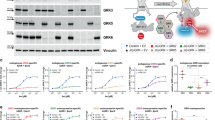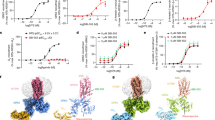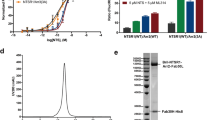Key Points
-
In the classical model of G-protein-coupled receptor (GPCR) regulation, arrestin proteins terminate receptor signalling. After receptor activation, arrestins desensitize GPCRs by binding to phosphorylated receptors, blocking further G-protein activation and initiating receptor internalization.
-
The desensitizing function of arrestins is exemplified physiologically in studies with knockout mice, which show that arrestins are crucial for the development of tolerance to, but not physical dependence on, morphine.
-
The conventional model of arrestin function is incomplete. Arrestins also link heptahelical receptors to several signalling pathways, including activation of the non-receptor tyrosine kinase SRC and mitogen-activated protein kinase. In these signalling cascades, arrestins function as adaptors and scaffolds, bringing sequentially acting kinases into proximity with each other and to the receptor.
-
The signalling roles of arrestins have been expanded with the discovery that, in Drosophila, the formation of stable receptor–arrestin complexes initiates photoreceptor cell apoptosis, leading to retinal cell degeneration.
Abstract
In the classical model of G-protein-coupled receptor (GPCR) regulation, arrestins terminate receptor signalling. After receptor activation, arrestins desensitize phosphorylated GPCRs, blocking further activation and initiating receptor internalization. This function of arrestins is exemplified by studies on the role of arrestins in the development of tolerance to, but not dependence on, morphine. Arrestins also link GPCRs to several signalling pathways, including activation of the non-receptor tyrosine kinase SRC and mitogen-activated protein kinase. In these cascades, arrestins function as adaptors and scaffolds, bringing sequentially acting kinases into proximity with each other and the receptor. The signalling roles of arrestins have been expanded even further with the discovery that the formation of stable receptor–arrestin complexes initiates photoreceptor apoptosis in Drosophila, leading to retinal degeneration. Here we review our current understanding of arrestin function, discussing both its classical and newly discovered roles.
This is a preview of subscription content, access via your institution
Access options
Subscribe to this journal
Receive 12 print issues and online access
$189.00 per year
only $15.75 per issue
Buy this article
- Purchase on Springer Link
- Instant access to full article PDF
Prices may be subject to local taxes which are calculated during checkout




Similar content being viewed by others
References
Freedman, N. J. & Lefkowitz, R. J. Desensitization of G protein-coupled receptors. Recent Prog. Horm. Res. 51, 319–351 (1996).
Lorenz, W. et al. The receptor kinase family: primary structure of rhodopsin kinase reveals similarities to the β-adrenergic receptor kinase. Proc. Natl Acad. Sci. USA 88, 8715–8719 (1991).
Rockman, H. A. et al. Control of myocardial contractile function by the level of β-adrenergic receptor kinase 1 in gene-targeted mice. J. Biol. Chem. 273, 18180–18184 (1998).
Peppel, K. et al. G protein-coupled receptor kinase 3 (GRK3) gene disruption leads to loss of odorant receptor desensitization. J. Biol. Chem. 272, 25425–25428 (1997).
Gainetdinov, R. R. et al. Muscarinic supersensitivity and impaired receptor desensitization in G protein-coupled receptor kinase 5-deficient mice. Neuron 24, 1029–1036 (1999).
Premont, R. T. et al. The GRK4 subfamily of G protein-coupled receptor kinases. Alternative splicing, gene organization, and sequence conservation. J. Biol. Chem. 274, 29381–29389 (1999).
Weiss, E. R. et al. The cloning of GRK7, a candidate cone opsin kinase, from cone- and rod-dominant mammalian retinas. Mol. Vis. 4, 27 (1998).
Benovic, J. L. et al. Functional desensitization of the isolated β-adrenergic receptor by the β-adrenergic receptor kinase: potential role of an analog of the retinal protein arrestin (48-kDa protein). Proc. Natl Acad. Sci. USA 84, 8879–8882 (1987).
Wilden, U., Wust, E., Weyand, I. & Kuhn, H. Rapid affinity purification of retinal arrestin (48 kDa protein) via its light-dependent binding to phosphorylated rhodopsin. FEBS Lett. 207, 292–295 (1986).
Lohse, M. J., Benovic, J. L., Codina, J., Caron, M. G. & Lefkowitz, R. J. β-arrestin: a protein that regulates β-adrenergic receptor function. Science 248, 1547–1550 (1990).
Attramadal, H. et al. β-arrestin2, a novel member of the arrestin/β-arrestin gene family. J. Biol. Chem. 267, 17882–17890 (1992).
Craft, C. M., Whitmore, D. H. & Wiechmann, A. F. Cone arrestin identified by targeting expression of a functional family. J. Biol. Chem. 269, 4613–4619 (1994).
Von Zastrow, M. & Kobilka, B. K. Ligand-regulated internalization and recycling of human β2-adrenergic receptors between the plasma membrane and endosomes containing transferrin receptors. J. Biol. Chem. 267, 3530–3538 (1992).
Ferguson, S. S. et al. Role of β-arrestin in mediating agonist-promoted G protein-coupled receptor internalization. Science 271, 363–366 (1996).
Goodman, O. B. Jr et al. β-arrestin acts as a clathrin adaptor in endocytosis of the β2-adrenergic receptor. Nature 383, 447–450 (1996).
Laporte, S. A. et al. The β2-adrenergic receptor/βarrestin complex recruits the clathrin adaptor AP-2 during endocytosis. Proc. Natl Acad. Sci. USA 96, 3712–3717 (1999).
Gaidarov, I., Krupnick, J. G., Falck, J. R., Benovic, J. L. & Keen, J. H. Arrestin function in G protein-coupled receptor endocytosis requires phosphoinositide binding. EMBO J. 18, 871–881 (1999).
Chun, M., Liyanage, U. K., Lisanti, M. P. & Lodish, H. F. Signal transduction of a G protein-coupled receptor in caveolae: colocalization of endothelin and its receptor with caveolin. Proc. Natl Acad. Sci. USA 91, 11728–11732 (1994).
Kohout, T. A., Lin, F. S., Perry, S. J., Conner, D. A. & Lefkowitz, R. J. β-Arrestin 1 and 2 differentially regulate heptahelical receptor signaling and trafficking. Proc. Natl Acad. Sci. USA 98, 1601–1606 (2001).Using cells from mouse embryos lacking β-arrestin 1, β-arrestin 2 or both, the authors show the central roles of β-arrestins in GPCR desensitization, internalization and downregulation.
Oakley, R. H., Laporte, S. A., Holt, J. A., Caron, M. G. & Barak, L. S. Differential affinities of visual arrestin, βarrestin1, and βarrestin2 for GPCRs delineate two major classes of receptors. J. Biol. Chem. 275, 17201–17210 (2000).
Oakley, R. H., Laporte, S. A., Holt, J. A., Barak, L. S. & Caron, M. G. Molecular determinants underlying the formation of stable intracellular G protein-coupled receptor–β-arrestin complexes after receptor endocytosis. J. Biol. Chem. 276, 19452–19460 (2001).
Oakley, R. H., Laporte, S. A., Holt, J. A., Barak, L. S. & Caron, M. G. Association of β-arrestin with G protein-coupled receptors during clathrin-mediated endocytosis dictates the profile of receptor resensitization. J. Biol. Chem. 274, 32248–32257 (1999).
Pals-Rylaarsdam, R. et al. Internalization of the m2 muscarinic acetylcholine receptor. Arrestin-independent and -dependent pathways. J. Biol. Chem. 272, 23682–23689 (1997).
Conner, D. A. et al. β-arrestin1 knockout mice appear normal but demonstrate altered cardiac responses to β-adrenergic stimulation. Circ. Res. 81, 1021–1026 (1997).
Bohn, L. M. et al. Enhanced morphine analgesia in mice lacking β-arrestin 2. Science 286, 2495–2498 (1999).Using mice lacking β-arrestin 2, Bohn et al . show the crucial role of β-arrestin 2 in the development of tolerance to opioids.
Bohn, L. M., Gainetdinov, R. R., Lin, F. T., Lefkowitz, R. J. & Caron, M. G. μ-Opioid receptor desensitization by β-arrestin-2 determines morphine tolerance but not dependence. Nature 408, 720–723 (2000).
Keith, D. E. et al. μ-Opioid receptor internalization: opiate drugs have differential effects on a conserved endocytic mechanism in vitro and in the mammalian brain. Mol. Pharmacol. 53, 377–384 (1998).
Luttrell, L. M. et al. β-arrestin-dependent formation of β2 adrenergic receptor–Src protein kinase complexes. Science 283, 655–661 (1999).
Luttrell, L. M., Della Rocca, G. J., Van Biesen, T., Luttrell, D. K. & Lefkowitz, R. J. Gβγ subunits mediate Src-dependent phosphorylation of the epidermal growth factor receptor. A scaffold for G protein-coupled receptor-mediated Ras activation. J. Biol. Chem. 272, 4637–4644 (1997).
Ahn, S., Maudsley, S., Luttrell, L. M., Lefkowitz, R. J. & Daaka, Y. Src-mediated tyrosine phosphorylation of dynamin is required for β2-adrenergic receptor internalization and mitogen-activated protein kinase signaling. J. Biol. Chem. 274, 1185–1188 (1999).
Wilde, A. et al. EGF receptor signaling stimulates SRC kinase phosphorylation of clathrin, influencing clathrin redistribution and EGF uptake. Cell 96, 677–687 (1999).
Daaka, Y. et al. Essential role for G protein-coupled receptor endocytosis in the activation of mitogen-activated protein kinase. J. Biol. Chem. 273, 685–688 (1998).
Miller, W. E. et al. β-arrestin1 interacts with the catalytic domain of the tyrosine kinase c-SRC. Role of β-arrestin1-dependent targeting of c-SRC in receptor endocytosis. J. Biol. Chem. 275, 11312–11319 (2000).
Barlic, J. et al. Regulation of tyrosine kinase activation and granule release through β-arrestin by CXCR1. Nature Immunol. 1, 227–233 (2000).
DeFea, K. A. et al. β-arrestin-dependent endocytosis of proteinase-activated receptor 2 is required for intracellular targeting of activated ERK1/2. J. Cell Biol. 148, 1267–1281 (2000).
DeFea, K. A. et al. The proliferative and antiapoptotic effects of substance P are facilitated by formation of a β-arrestin-dependent scaffolding complex. Proc. Natl Acad. Sci. USA 97, 11086–11091 (2000).
Luttrell, L. M. et al. Activation and targeting of extracellular signal-regulated kinases by β-arrestin scaffolds. Proc. Natl Acad. Sci. USA 98, 2449–2454 (2001).
McDonald, P. H. et al. β-Arrestin 2: a receptor-regulated MAPK scaffold for the activation of JNK3. Science 290, 1574–1577 (2000).Shows that β-arrestin 2, but not β-arrestin 1, scaffolds the sequentially acting kinases in the JNK3 cascade, leading to the activation and cytosolic retention of JNK3. So, in addition to their roles in turning off GPCR signalling pathways, β-arrestins also promote GPCR signalling.
Kiselev, A. et al. A molecular pathway for light-dependent photorecptor apoptosis in Drosophila. Neuron 28, 139–152 (2000).
Alloway, P. G., Howard, L. & Dolph, P. J. The formation of stable rhodopsin–arrestin complexes induces apoptosis and photoreceptor cell degeneration. Neuron 28, 129–138 (2000).References 39 and 40 establish the central role of a Drosophila β-arrestin homologue in internalization-dependent photoreceptor cell degeneration, showing an in vivo role for arrestins in apoptosis.
Van Soest, S., Westerveld, A., De Jong, P. T., Bleeker-Wagemakers, E. M. & Bergen, A. A. Retinitis pigmentosa: defined from a molecular point of view. Surv. Ophthalmol. 43, 321–334 (1999).
Acknowledgements
This work was supported by a grant from the National Institutes of Health (#HL 16037). R.J.L. is an investigator at the Howard Hughes Medical Institute. We would like to thank D. Addison, M. Holben and J. Turnbough for their excellent secretarial assistance.
Author information
Authors and Affiliations
Corresponding author
Related links
Related links
DATABASE LINKS
Glossary
- ENDOSOME
-
An organelle that carries materials ingested by endocytosis and passes them to lysosomes for degradation or recycles them to the cell surface.
- TRANSFERRIN
-
A metal-binding glycoprotein involved in ferric ion uptake into the cell. The pathway followed by transferrin bound to its receptor defines a classical recycling pathway.
- CLATHRIN
-
A major structural component of coated vesicles that are implicated in protein transport. Clathrin heavy and light chains form a triskelion, the main building element of clathrin coats.
- AP-2 COMPLEX
-
A heterotetrameric complex composed of subunits called adaptins. It is one of the main components of the coats formed during membrane endocytosis.
- CAVEOLAE
-
Flask-shaped, cholesterol-rich invaginations of the plasma membrane that might mediate the uptake of extracellular materials, and are probably involved in cell signalling.
- CARDIAC EJECTION FRACTION
-
A measure of the pumping efficiency of the heart. The ejection fraction is the amount of blood ejected from the left ventricle with each heartbeat, expressed as a percentage of the total amount of blood in the heart at the beginning of contraction. The normal ejection fraction lies between 55% and 75%.
- MITOGEN-ACTIVATED PROTEIN KINASE CASCADE
-
A signalling cascade that relays signals from the plasma membrane to the nucleus. Mitogen-activated protein kinases (MAPKs), which represent the last step in the pathway, are activated by a wide range of proliferation- or differentiation-inducing signals. Extracellular-signal-regulated kinases (ERKs) are among the best-characterized MAPKs.
- SRC
-
The first proto-oncogene to be identified. It codes for a non-receptor protein tyrosine kinase.
- DYNAMIN
-
A GTPase that is involved in endocytosis. It is thought to be involved in severing the connection between the nascent vesicle and the donor membrane.
- CHEMOKINES
-
Small, secreted proteins that stimulate the motile behaviour of leukocytes.
- POLYMORPHONUCLEAR NEUTROPHIL
-
A phagocytic cell that has an important role in the inflammatory response, undergoing chemotaxis towards sites of infection or wounding. It is characterized by the presence of cytoplasmic granules that are not stained by acidic or basic dyes, hence the name 'neutrophil'.
- C-JUN N-TERMINAL KINASES
-
A family of kinases, distantly related to extracellular-signal-regulated kinases (ERKs), that are activated by dual phosphorylation on tyrosine and threonine residues. JNK3 is mainly found in neurons and might participate in the regulation of apoptosis.
- JUN-KINASE-INTERACTING PROTEINS
-
Proteins that bind to c-Jun N-terminal kinase (JNK) in vitro and in vivo. They can also bind to upstream components of the JNK pathway, indicating that they might function as a scaffold proteins that regulate the specificity of JNK signalling.
- RETINITIS PIGMENTOSA
-
An inherited condition of the retina, in which rods degenerate. The loss of rods diminishes the patient's ability to see in dim light and can also diminish peripheral vision.
Rights and permissions
About this article
Cite this article
Pierce, K., Lefkowitz, R. Classical and new roles of β-arrestins in the regulation of G-PROTEIN-COUPLED receptors. Nat Rev Neurosci 2, 727–733 (2001). https://doi.org/10.1038/35094577
Issue Date:
DOI: https://doi.org/10.1038/35094577
This article is cited by
-
HTR2A agonists play a therapeutic role by restricting ILC2 activation in papain-induced lung inflammation
Cellular & Molecular Immunology (2023)
-
β-Arrestin-1 is required for adaptive β-cell mass expansion during obesity
Nature Communications (2021)
-
Prospects of a Search for Kappa-Opioid Receptor Agonists with Analgesic Activity (Review)
Pharmaceutical Chemistry Journal (2018)
-
A synthetic intrabody-based selective and generic inhibitor of GPCR endocytosis
Nature Nanotechnology (2017)
-
β-Arrestins promote podocyte injury by inhibition of autophagy in diabetic nephropathy
Cell Death & Disease (2016)



